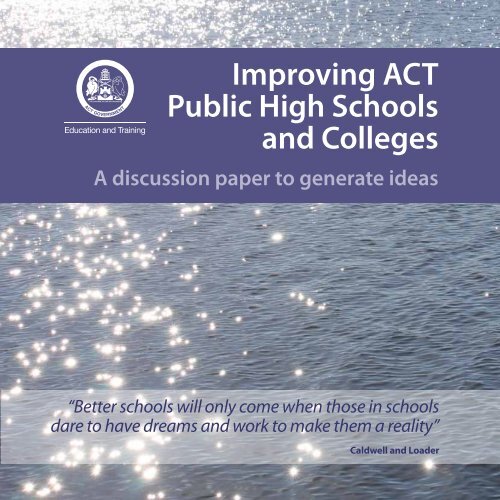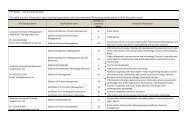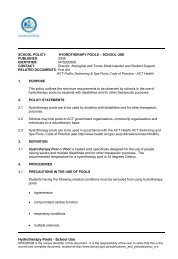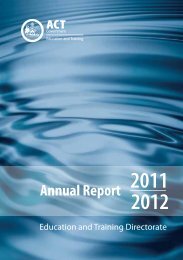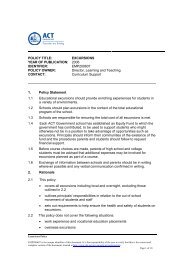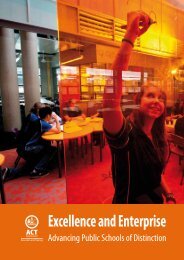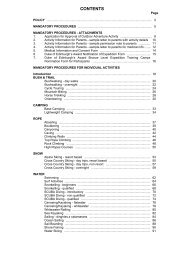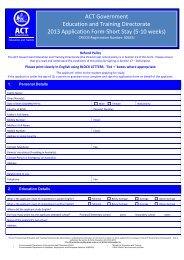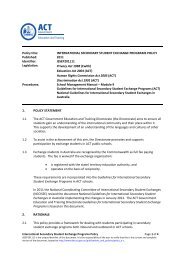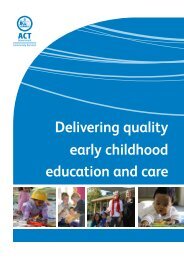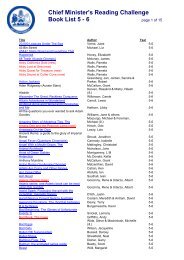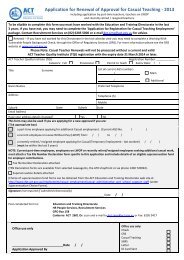Improving ACT High Schools and Colleges - Education and Training ...
Improving ACT High Schools and Colleges - Education and Training ...
Improving ACT High Schools and Colleges - Education and Training ...
You also want an ePaper? Increase the reach of your titles
YUMPU automatically turns print PDFs into web optimized ePapers that Google loves.
<strong>Improving</strong> <strong>ACT</strong><br />
Public <strong>High</strong> <strong>Schools</strong><br />
<strong>and</strong> <strong>Colleges</strong><br />
A discussion paper to generate ideas<br />
“Better schools will only come when those in schools<br />
dare to have dreams <strong>and</strong> work to make them a reality”<br />
Caldwell <strong>and</strong> Loader
Everyone matters<br />
There are almost 40,000 students enrolled in <strong>ACT</strong> public<br />
schools. In our early childhood schools, primary schools,<br />
high schools <strong>and</strong> colleges, children <strong>and</strong> young people<br />
are developing the skills <strong>and</strong> underst<strong>and</strong>ing needed to<br />
succeed in school <strong>and</strong> beyond.<br />
Our vision is to support <strong>and</strong> engage all young people in<br />
the <strong>ACT</strong> so that they<br />
“learn, thrive <strong>and</strong> are equipped with the skills<br />
to lead fulfilling, productive <strong>and</strong> responsible<br />
lives”<br />
<strong>ACT</strong> Department of <strong>Education</strong> <strong>and</strong> <strong>Training</strong><br />
Strategic Plan 2010-2013: Everyone matters<br />
Our commitment is to every student, ensuring that each<br />
is engaged in learning through a personalised approach,<br />
positioning them for lifelong success.<br />
We will continue to foster high quality stakeholder<br />
participation in school communities to ensure students<br />
are supported <strong>and</strong> engaged to achieve their full<br />
potential.<br />
2
Message from the Minister<br />
Secondary education in the <strong>ACT</strong> has strong foundations. Our schools <strong>and</strong><br />
colleges have served us well but are now facing new challenges. We need to<br />
provide for all students, <strong>and</strong> model best practice for the nation. We must<br />
strive to be better <strong>and</strong> stay ahead of the game.<br />
Over the past few years we have invested in new schools <strong>and</strong> new school<br />
models, in curriculum renewal, literacy <strong>and</strong> numeracy learning, information<br />
technology <strong>and</strong> quality teacher professional development. Our high schools<br />
<strong>and</strong> colleges have developed vocational education <strong>and</strong> training opportunities<br />
to give students a more diverse range of career <strong>and</strong> education options.<br />
We know education is important to every young person, which is why we have increased the school leaving age<br />
to 17. And we know that a skilled, adaptable, educated workforce will benefit both our community <strong>and</strong> our<br />
economy.<br />
We are having discussions with the community to transform our tertiary <strong>and</strong> training l<strong>and</strong>scape so that we can<br />
respond to skills shortages effectively <strong>and</strong> meet our future social <strong>and</strong> economic challenges. Now we are turning<br />
our focus to our high schools <strong>and</strong> colleges. Our high schools <strong>and</strong> colleges are changing. They are developing plans<br />
<strong>and</strong> programs of study to meet the individual needs of their students. But more needs to be done.<br />
We are looking for new <strong>and</strong> innovative ideas that will help our school system cater better for the aspirations <strong>and</strong><br />
interests of young people in the <strong>ACT</strong>. We want to create a connected, integrated education environment that will<br />
excite <strong>and</strong> engage our students <strong>and</strong> encourage them to adopt the philosophy of lifelong learning. In short, we<br />
are looking for ideas to improve <strong>and</strong> energise our public education system <strong>and</strong> everyone who comes into<br />
contact with it.<br />
I want to create a vision that sets the <strong>ACT</strong> apart as Australia’s lifelong learning capital. We have begun working on<br />
our tertiary sector. This discussion paper opens the conversation about our secondary schools. I invite you to help<br />
shape our schools for the future.<br />
Andrew Barr MLA<br />
Minister for <strong>Education</strong> <strong>and</strong> <strong>Training</strong><br />
July 2010<br />
3
Our challenge<br />
In October 2009 the <strong>ACT</strong> Minister for <strong>Education</strong> <strong>and</strong> <strong>Training</strong>, Andrew Barr<br />
MLA, identified secondary <strong>and</strong> post-secondary education as the areas of the<br />
public education l<strong>and</strong>scape requiring reform <strong>and</strong> renewal. 1 He also identified<br />
the challenges ahead in ensuring every student has a learning pathway that<br />
will allow them to progress from middle years schooling to the senior years<br />
<strong>and</strong> on to tertiary education <strong>and</strong> training. This builds on achievements in<br />
early years learning, improved teacher quality, investments in Aboriginal <strong>and</strong><br />
Torres Strait Isl<strong>and</strong>er <strong>and</strong> disability education <strong>and</strong> more consistent curriculum<br />
provision.<br />
The Minister emphasised the need to strengthen the coordination between<br />
schools, the training sector <strong>and</strong> universities, <strong>and</strong> to build partnerships<br />
with business <strong>and</strong> the community to ensure that our education system<br />
can continue to provide opportunities that engage <strong>and</strong> excite every young<br />
person in the <strong>ACT</strong>.<br />
On 1 January 2010 the <strong>ACT</strong> Government amended the <strong>Education</strong> Act 2004.<br />
Young people will now need to stay in education until they complete<br />
year 10, then be in education, training or employment until completing<br />
year 12 or equivalent, or reaching age 17, whichever occurs first. The <strong>ACT</strong><br />
Youth Commitment was developed as a consequence of amendments to<br />
the <strong>Education</strong> Act. The Youth Commitment means that all students will be<br />
supported <strong>and</strong> tracked in their education, training or employment.<br />
Our retention rates to year 12 are strong in comparison to other jurisdictions<br />
in Australia. Over 80% of people aged 19 in the <strong>ACT</strong> have attained year 12<br />
compared to the national figure of 69%. 2 The <strong>ACT</strong> Government is aiming for<br />
100% retention to year 12 with maximum opportunities for everyone to<br />
transition to further education <strong>and</strong> employment.<br />
4<br />
1 Reporting in from the front line of reform, Address to the Per Capita Policy Exchange,<br />
Canberra, 2009.<br />
2 ABS Census of population <strong>and</strong> housing, 2006.
To meet this goal, we need to ensure that the community continues to<br />
have confidence in our public schools. The <strong>ACT</strong> public education system<br />
has arrested the flow of students leaving public education in recent years.<br />
We recognise that educational choice is healthy <strong>and</strong> <strong>ACT</strong> parents <strong>and</strong><br />
students are able to choose schools on the basis of family beliefs, values <strong>and</strong><br />
circumstances.<br />
Our challenge is to make <strong>ACT</strong> public secondary schools the schools of choice<br />
for all parents <strong>and</strong> students based firmly on the quality of our education<br />
programs <strong>and</strong> opportunities for students to excel.<br />
Our high schools <strong>and</strong> colleges are catering for students with an increasing<br />
range of abilities, interests <strong>and</strong> aspirations. As community expectations of<br />
schools grow, <strong>and</strong> the diversity of our student population increases, there is<br />
recognition that no school can meet the needs of all its students alone.<br />
<strong>Schools</strong> will need to develop opportunities to work with other schools <strong>and</strong><br />
to build partnerships with service providers, other education institutions,<br />
business, industry groups <strong>and</strong> the community.<br />
We need to build on current good practice while transforming our traditional<br />
education structures. We need to encourage the use of digital technologies,<br />
more flexible timetables <strong>and</strong> learning opportunities <strong>and</strong> the reshaping of<br />
schools as connected learning communities.<br />
AN<br />
INVITATION...<br />
We are<br />
seeking your<br />
ideas to help<br />
shape our<br />
high schools<br />
<strong>and</strong> colleges<br />
for the future.<br />
We need to enhance our schools’ capacities to deliver:<br />
• academic excellence<br />
• high quality vocational education <strong>and</strong> training opportunities<br />
• relevant pathways through schooling <strong>and</strong> beyond<br />
• sustainable partnerships with:<br />
- other schools <strong>and</strong> educational providers<br />
- community organisations<br />
- business <strong>and</strong> industry.<br />
While individual schools <strong>and</strong> colleges are embarking on innovative programs<br />
<strong>and</strong> community partnerships, it is time to imagine a bigger picture. A<br />
picture that sees all <strong>ACT</strong> public schools systematically <strong>and</strong> strategically<br />
planning for equitable, meaningful learning pathways that engage all<br />
students.<br />
5
...<br />
<br />
6<br />
<br />
What if<br />
... high schools <strong>and</strong> colleges worked together as connected learning<br />
communities to offer greater choice to students<br />
... some schools offered courses in a range of locations<br />
... schools developed their curriculum in partnership with the Canberra<br />
Institute of Technology (CIT) or a university<br />
... students were able to combine school <strong>and</strong> work more formally<br />
... partnerships between schools <strong>and</strong> business gave students regular<br />
access to work-based training, mentor support <strong>and</strong> pathways from<br />
school to work<br />
... some schools had flexible timetables<br />
... the virtual school became a reality<br />
... some students worked from home or elsewhere<br />
... some schools offered two-shift days<br />
... we had girls’ or boys’ schools, or some schools offering single-sex<br />
classes<br />
... some schools offered accelerated learning for academically gifted<br />
students<br />
we had selective entry schools
... some schools developed centres of excellence for students with<br />
talents in areas such as mathematics, science <strong>and</strong> technology, languages<br />
<strong>and</strong> the humanities<br />
... students could develop personalised pathways across a range of<br />
education settings—schools, universities, CIT, industry <strong>and</strong> the<br />
community<br />
... schools in a local area became a federation of schools <strong>and</strong> pooled<br />
their resources to offer a broader curriculum to their students<br />
... partnerships were developed between public <strong>and</strong> non-government<br />
schools<br />
... new processes for graduating from high school to college were<br />
developed<br />
<br />
<br />
<br />
... some schools developed specialist programs for students with<br />
interests in particular sports (golf, tennis, athletics, rowing, football,<br />
hockey) or the performing arts, visual arts, graphic design, media <strong>and</strong><br />
communications<br />
<br />
7
Our context<br />
The <strong>ACT</strong> agenda<br />
The <strong>ACT</strong> has a proud history of educational achievement <strong>and</strong> innovation in<br />
its public school system. The dem<strong>and</strong>s <strong>and</strong> opportunities for young people<br />
are becoming more complex, <strong>and</strong> community expectations on education are<br />
growing. So we must consider how to best meet the needs of students in a<br />
local, national <strong>and</strong> international context.<br />
In 2006, in Towards 2020: Renewing our schools the <strong>ACT</strong> Government set out<br />
its vision for new school structures across the <strong>ACT</strong> to achieve high quality<br />
education into the future. These structures include early childhood schools<br />
<strong>and</strong> a range of models to enhance middle schooling, such as a year 6–10<br />
high school <strong>and</strong> P–10 schools. With the opening of Gungahlin College in<br />
2011, eight colleges <strong>and</strong> a year 7–12 school will provide options at the upper<br />
secondary level. Each school model has been designed to provide choices for<br />
contemporary learning <strong>and</strong> the best opportunities for local students.<br />
State-of-the-art facilities in all new public school buildings, <strong>and</strong> significant<br />
upgrades to existing infrastructure, have delivered greatly enhanced<br />
learning environments for our students in response to changing community<br />
expectations.<br />
8
We already have excellent practice <strong>and</strong> innovative thinking in our schools,<br />
but more can be done to invigorate current practice <strong>and</strong> learning programs.<br />
The <strong>ACT</strong> Government has invested in new technology, which will redefine<br />
the boundaries of what constitutes a school. Virtual learning environments<br />
will provide access to information <strong>and</strong> learning far beyond the walls of any<br />
school building.<br />
The <strong>ACT</strong> Government has introduced a systematic <strong>and</strong> targeted approach<br />
to school improvement by:<br />
• organising our schools into four networks, each led by a school network<br />
leader<br />
• increasing the availability <strong>and</strong> use of data to inform school improvement<br />
practices <strong>and</strong> monitor progress<br />
• supporting principals to ensure they are high quality instructional leaders<br />
• continuously <strong>and</strong> systematically building the capacity of teachers<br />
• enhancing the accountability of principals <strong>and</strong> school network leaders.<br />
The school networks provide the basis for greater collaboration <strong>and</strong> sharing<br />
between schools, with a focus on improving the performance of all schools<br />
within the network.<br />
Through Territory <strong>and</strong> Australian Government national partnerships, our<br />
public schools are improving literacy <strong>and</strong> numeracy learning, teacher quality<br />
<strong>and</strong> leadership capacity. From 2011 our schools will begin implementing<br />
the Australian Curriculum. Our schools are using more inclusive practices<br />
for students with disabilities, <strong>and</strong> non-English speaking students. We are<br />
increasing our efforts to ensure Aboriginal <strong>and</strong> Torres Strait Isl<strong>and</strong>er students<br />
graduate from year 12. At the college level, students are gaining greater<br />
access to a variety of courses, particularly in the vocational education <strong>and</strong><br />
training area.<br />
The <strong>ACT</strong> school system performs well on measures of international st<strong>and</strong>ards.<br />
The Australian Council for <strong>Education</strong>al Research (ACER) has reported that <strong>ACT</strong><br />
students are performing consistently better than the rest of Australia <strong>and</strong> 9
many other countries in the Programme for International Student Assessment<br />
(PISA). However, ACER also notes that the relative performance between <strong>ACT</strong><br />
students with high <strong>and</strong> low socio-economic indexes represents a ‘gap’ similar<br />
to groups of students in the Northern Territory <strong>and</strong> Tasmania, <strong>and</strong> greater<br />
than in all the other Australian jurisdictions.<br />
Another international assessment is the Trends in Mathematics <strong>and</strong><br />
Science Study (TIMSS) which is an indicator of knowledge <strong>and</strong> abilities in<br />
mathematics <strong>and</strong> science at years 4 <strong>and</strong> 8. The <strong>ACT</strong> is a high performer<br />
relative to national <strong>and</strong> international st<strong>and</strong>ards, ranked first when compared<br />
to other Australian jurisdictions, <strong>and</strong> sixth <strong>and</strong> eighth respectively in<br />
mathematics <strong>and</strong> science when ranked against the 49 international<br />
participants. 3 Maintaining this high level of performance creates a challenge<br />
for our system particularly at the international level where our Asian<br />
neighbours continue to improve at impressive rates.<br />
The national agenda<br />
In 2008 the Australian Government embarked on a school reform agenda<br />
for the nation. The Council of Australian Governments (COAG) has agreed to<br />
major national growth targets that include:<br />
• the achievement of a national year 12 or equivalent attainment rate of<br />
90% by 2015<br />
• halving the gap for Aboriginal <strong>and</strong> Torres Strait Isl<strong>and</strong>er students attaining<br />
year 12 or equivalent by 2020<br />
• halving the gap for Aboriginal <strong>and</strong> Torres Strait Isl<strong>and</strong>er students in<br />
reading, writing <strong>and</strong> numeracy within a decade<br />
• entitlement to an education or training place for 15 to 24 year olds which<br />
focuses on attaining year 12 or equivalent qualifications.<br />
10<br />
In 2009 the Australian Government accepted the Bradley Review<br />
recommendation to deregulate university enrolment. From 2012, tertiary<br />
3 Overall Australia was ranked 14th out of 49 countries in mathematics <strong>and</strong> 13th out of 49 in science.
institutions will be free to determine student enrolment numbers. It also<br />
accepted the Bradley Review recommendation that by 2020, 20% of students<br />
enrolled in higher education should come from low socio-economic<br />
backgrounds. Achieving these targets requires new strategies to engage<br />
students in learning for longer.<br />
The international perspective<br />
Today’s students are digital learners immersed in a culture of technology.<br />
They underst<strong>and</strong> how to use <strong>and</strong> access digital tools. The classroom is no<br />
longer just local, <strong>and</strong> our students now participate in <strong>and</strong> contribute to<br />
learning beyond the walls of their schools. They are part of a global learning<br />
environment <strong>and</strong> we need to reflect this as we plan new models of schooling.<br />
Learning in the 21st century <strong>and</strong> beyond has been described by researchers<br />
from the Organisation for Economic Co-operation <strong>and</strong> Development (OECD)<br />
<strong>and</strong> the Innovation Unit (United Kingdom) as including:<br />
• the student being placed at the centre of the learning<br />
• learning pathways that are personalised <strong>and</strong> varied to engage students<br />
• real life experiences <strong>and</strong> real life learning that form the basis of<br />
educational experiences for all students<br />
• teachers who have a wider range of skills <strong>and</strong> strategies, with increased<br />
focus on the use of technology underpinning the student learning<br />
• productive learning pathways that are pursued with enrolment in more<br />
than a single school at any one time.<br />
We must adapt <strong>and</strong> innovate to meet the dem<strong>and</strong>s of 21st century learners<br />
<strong>and</strong> to meet local <strong>and</strong> national targets while competing in a new global<br />
economy requiring high levels of skill <strong>and</strong> knowledge.<br />
The chart on the following page provides a visual depiction of our context.<br />
11
Influences on the <strong>ACT</strong> <strong>Education</strong> <strong>and</strong> <strong>Training</strong> l<strong>and</strong>scape<br />
International education<br />
trends<br />
National<br />
Tertiary Agenda<br />
Canberra Plan<br />
<strong>ACT</strong> Tertiary Taskforce<br />
<strong>ACT</strong> & national<br />
economy<br />
Australian<br />
Curriculum<br />
<strong>Improving</strong> <strong>ACT</strong> Public<br />
<strong>High</strong> <strong>Schools</strong> <strong>and</strong> <strong>Colleges</strong><br />
Youth<br />
Commitment<br />
National Partnerships<br />
School Improvement Strategy<br />
Early Childhood <strong>Schools</strong> Primary <strong>Schools</strong> Specialist <strong>Schools</strong><br />
12
Have your say<br />
To meet the challenges in our high schools <strong>and</strong> colleges, we are seeking<br />
ideas from students <strong>and</strong> young people, teachers <strong>and</strong> support staff, parents<br />
<strong>and</strong> community members, colleagues from other education settings, <strong>and</strong><br />
business <strong>and</strong> industry.<br />
The following questions are provided to guide your input:<br />
1<br />
2<br />
3<br />
4<br />
What needs to be strengthened or changed so that <strong>ACT</strong><br />
public schools <strong>and</strong> colleges are schools of choice<br />
What needs to be done in <strong>ACT</strong> public schools <strong>and</strong> colleges to<br />
improve school graduation rates <strong>and</strong> ensure every student<br />
has a pathway to tertiary education <strong>and</strong> training or<br />
meaningful work<br />
How can <strong>ACT</strong> public high schools <strong>and</strong> colleges be better<br />
connected to other education providers <strong>and</strong> the community<br />
to extend choice <strong>and</strong> opportunity for all students<br />
Where are the opportunities for innovation <strong>and</strong> growth that<br />
will ensure the <strong>ACT</strong> public school system is meeting the needs<br />
<strong>and</strong> aspirations of our students <strong>and</strong> the broader <strong>ACT</strong><br />
community<br />
Our vision<br />
“That all<br />
young people<br />
in the <strong>ACT</strong><br />
learn, thrive<br />
<strong>and</strong> are<br />
equipped with<br />
the skills to<br />
lead fulfilling,<br />
productive<br />
<strong>and</strong><br />
responsible<br />
lives”<br />
<strong>ACT</strong> Department of<br />
<strong>Education</strong> <strong>and</strong> <strong>Training</strong><br />
Strategic Plan 2010–2013:<br />
Everyone matters<br />
13
How to provide feedback<br />
For information on how to provide feedback, visit the Department of<br />
<strong>Education</strong> <strong>and</strong> <strong>Training</strong> website: www.det.act.gov.au<br />
If you have any queries on this discussion paper, please email<br />
det.consultation@act.gov.au<br />
Written feedback should be sent to:<br />
<strong>High</strong> School <strong>and</strong> College Consultation<br />
Department of <strong>Education</strong> <strong>and</strong> <strong>Training</strong><br />
GPO Box 158<br />
CANBERRA <strong>ACT</strong> 2601<br />
or<br />
email your feedback to det.consultation@act.gov.au<br />
The closing date for feedback is Tuesday 7 September 2010.<br />
14
What happens next<br />
The Department will draw on the submissions, consultations <strong>and</strong> ideas from<br />
schools <strong>and</strong> their local communities to develop a report to the Minister<br />
for <strong>Education</strong> <strong>and</strong> <strong>Training</strong>. It will include recommendations about how to<br />
improve our high schools <strong>and</strong> colleges. This will ensure that every student<br />
is engaged in productive learning <strong>and</strong> has relevant pathways to progress<br />
through the middle <strong>and</strong> senior years of schooling <strong>and</strong> on to tertiary<br />
education <strong>and</strong> training.<br />
For more information<br />
Everyone matters, <strong>ACT</strong> Department of <strong>Education</strong> <strong>and</strong> <strong>Training</strong> Strategic Plan<br />
2010–2013<br />
www.det.act.gov.au See Publications<br />
Reporting in from the front line of reform, Address to the Per Capita Policy<br />
Exchange, Canberra, 2009<br />
www.<strong>and</strong>rewbarr.com.au/node/419<br />
Supporting Business–School Connections, Discussion paper of the Business–<br />
School Connections Roundtable, July 2010<br />
www.deewr.gov.au/Schooling/Pages/Roundtable.aspx<br />
Melbourne Declaration on <strong>Education</strong>al Goals for Young Australians, MCEECDYA,<br />
December 2008<br />
www.mceecdya.edu.au/mceecdya See Publications<br />
Review of Australian <strong>High</strong>er <strong>Education</strong>, Final report of the expert panel chaired<br />
by Professor Denise Bradley, December 2008<br />
www.deewr.gov.au See <strong>High</strong>er <strong>Education</strong><br />
15
<strong>ACT</strong> Department of <strong>Education</strong> <strong>and</strong> <strong>Training</strong><br />
GPO Box 158, Canberra <strong>ACT</strong> 2601<br />
Telephone: (02) 6205 9400<br />
Web site: www.det.act.gov.au<br />
Facsimile: (02) 6205 8353<br />
Publication No: 10/0865


